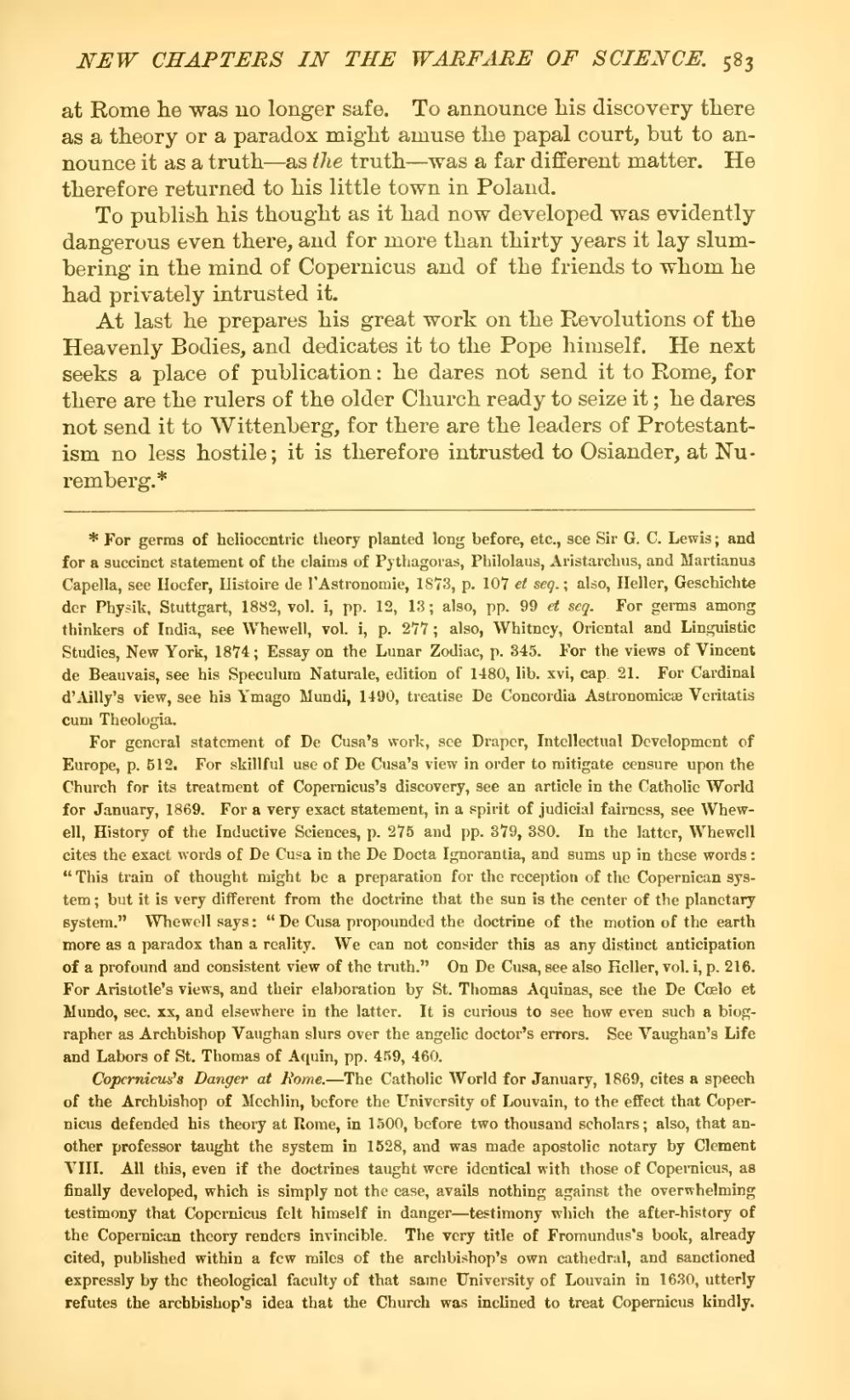at Rome he was no longer safe. To announce his discovery there as a theory or a paradox might amuse the papal court, but to announce it as a truth—as the truth—was a far different matter. He therefore returned to his little town in Poland.
To publish his thought as it had now developed was evidently dangerous even there, and for more than thirty years it lay slumbering in the mind of Copernicus and of the friends to whom he had privately intrusted it.
At last he prepares his great work on the Revolutions of the Heavenly Bodies, and dedicates it to the Pope himself. He next seeks a place of publication: he dares not send it to Rome, for there are the rulers of the older Church ready to seize it; he dares not send it to Wittenberg, for there are the leaders of Protestantism no less hostile; it is therefore intrusted to Osiander, at Nuremberg.[1]
- ↑ For germs of heliocentric theory planted long before, etc., see Sir G. C. Lewis; and for a succinct statement of the claims of Pythagoras, Philolaus, Aristarchus, and Martianus Capella, see Hoefer, Histoire de l'Astronomie, 1873, p. 107 et seq.; also, Heller, Geschichte der Physik, Stuttgart, 1882, vol. i, pp. 12, 13; also, pp. 99 et seq. For germs among thinkers of India, see Whewell, vol. i, p. 277; also, Whitney, Oriental and Linguistic Studies, New York, 1874; Essay on the Lunar Zodiac, p. 345. For the views of Vincent de Beauvais, see his Speculum Naturale, edition of 1480, lib. xvi, cap. 21. For Cardinal d'Ailly's view, see his Ymago Mundi, 1490, treatise De Concordia Astronomicaæ Veritatis cum Theologia.
For general statement of De Cusa's work, see Draper, Intellectual Development of Europe, p. 512. For skillful use of De Cusa's view in order to mitigate censure upon the Church for its treatment of Copernicus's discovery, see an article in the Catholic World for January, 1869. For a very exact statement, in a spirit of judicial fairness, see Whewell, History of the Inductive Sciences, p. 275 and pp. 379, 380. In the latter, Whewell cites the exact words of De Cusa in the De Docta Ignorantia, and sums up in these words: "This train of thought might be a preparation for the reception of the Copernican system; but it is very different from the doctrine that the sun is the center of the planetary system." Whewell says; "De Cusa propounded the doctrine of the motion of the earth more as a paradox than a reality. We can not consider this as any distinct anticipation of a profound and consistent view of the truth." On De Cusa, see also Heller, vol. i, p. 216. For Aristotle's views, and their elaboration by St. Thomas Aquinas, see the De Cœlo et Mundo, sec. xx, and elsewhere in the latter. It is curious to see how even such a biographer as Archbishop Vaughan slurs over the angelic doctor's errors. See Vaughan's Life and Labors of St. Thomas of Aquin, pp. 459, 460.
Copernicus's Danger at Rome.—The Catholic World for January, 1869, cites a speech of the Archbishop of Mechlin, before the University of Louvain, to the effect that Copernicus defended his theory at Rome, in 1500, before two thousand scholars; also, that another professor taught the system in 1528, and was made apostolic notary by Clement VIII. All this, even if the doctrines taught were identical with those of Copernicus, as finally developed, which is simply not the case, avails nothing against the overwhelming testimony that Copernicus felt himself in danger—testimony which the after-history of the Copernican theory renders invincible. The very title of Fromundus's book, already cited, published within a few miles of the archbishop's own cathedral, and sanctioned expressly by the theological faculty of that same University of Louvain in 1630, utterly refutes the archbishop's idea that the Church was inclined to treat Copernicus kindly.
